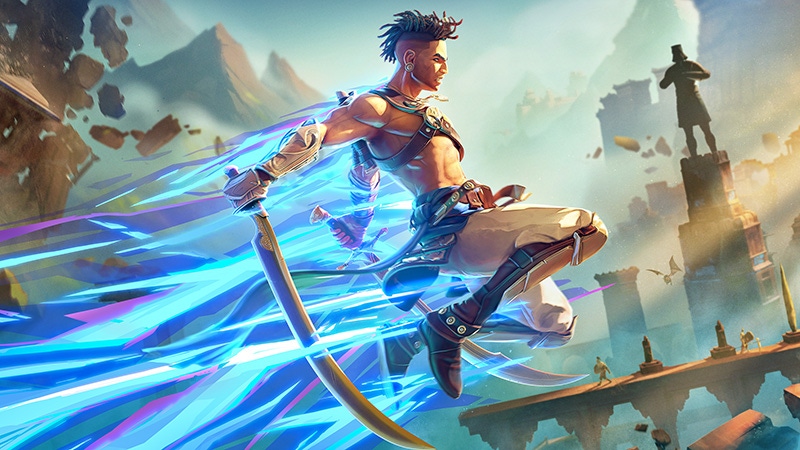Prince of Persia: The Lost Crown revives the series' side-scrolling past
Ubisoft senior game producer Abdelhak Elguess explains how the developer rebooted a traditional adventure series into a stylized action game.

The Prince of Persia franchise has seen many reimaginings since its debut in 1989. As one of the most influential action-adventure games, the original Prince of Persia from creator Jordan Mechner put players in sprawling, One Thousand and One Nights-inspired dungeons filled with traps, dangerous foes, and challenging traversal puzzles to overcome. With the surprise reveal of the Prince of Persia: The Lost Crown, we see the series make its inevitable but also appropriate first step into the popular 2D Metroidvania sub-genre.
I played an hour of the game during a special media event following the recent Ubisoft Showcase, and spoke with senior game producer Abdelhak Elguess from Ubisoft Montpellier about how the next revival for one of gaming's most classic adventure franchises adds some modern twists, and how Prince of Persia compliments the Metroidvania format.
Stepping back into a stylized past
The enduring conceit of Prince of Persia is about exploring and surviving settings inspired by classic adventure narratives and Middle Eastern folklore from One Thousand and One Nights. The Lost Crown brings that premise into a more expansive scope that's about building up the protagonist's abilities, interacting with additional characters, and uncovering what happened within the game's fractured world. When speaking with the game's lead producer, he said it was about taking some risks to update the franchise's classic formula.
"It's a big responsibility, and we took the task of modernizing Prince of Persia with humility," said Elguess about planning the reboot. "We try to really respect the DNA of the brand, that classic adventure premise, but we also needed to bring some modernity to the formula, to take some creative risks, and to make it more badass, but at the same time making it feel like a piece of the larger Prince of Persia series."
In an interesting twist, Prince of Persia: The Lost Crown doesn't put you in the titular role, but instead, you play as a young warrior named Sargon who is on a rescue mission to find the missing Prince. As the youngest member of the Immortals, a renowned band of warriors, the party travels to a kingdom that has fallen into disarray. With a magical corruption spreading and the fabric of time warping, Sargon faces off against dangerous monsters and perilous platforming puzzles in his quest to rescue his allies and uncover what happened to the kingdom.

The premise is quite close to earlier games like 2004's The Sands of Time or 2008's Prince of Persia, but what The Lost Crown does differently is present a more stylized take on 2D action and platforming that the franchise was built on. Stepping into the Metroidvania format, The Lost Crown has you explore its large, interconnected world inspired by ancient Persia and folklore. It builds out its world and power growth in a similar fashion to games like Super Metroid or Hollow Knight, and from my early hands-on, it felt like a natural fit for the series.
The Lost Crown's visual style and approach to an open-ended adventure contrasts it with other series games, which went for more earnest and narrative-driven takes on its setting. The devs at Ubisoft Montpellier cited action-packed Japanese anime as an inspiration, but they also stated that their work on the recent Rayman games gave them confidence in building a new Prince of Persia game that highlights and expands the action-platforming roots of the classic 2D games.
Classic design with Metroidvania-style
The Lost Crown is an action-heavy game that favors freedom in exploration, which was a refreshing change from the more set-piece-driven entries of the series. From my hour with the game, I got a sense of a certain mindfulness in updating the classic formula of combat, platforming, and puzzle solving. It has a strong adventure vibe but with a stylized focus on action and power growth, which brings a certain energy that feels new to the franchise.
Much like the classic 2D Prince of Persia games, The Lost Crown is challenging but in its own way. It is the most 'video-gamey' interpretation of a traditional 2D Prince of Persia game, with Sargon gaining new abilities, unlocking new areas of the world, and facing daunting boss battles against demons and undead monsters. Combat is thrilling yet very challenging, as it focuses on reading your opponent's moves to parry and counterattack with your skills. It felt very rooted in the series' approach to tense combat and daring traversal challenges.

A particular stand-out moment during my hands-on was when I reached a dense series of underground caverns, which led to an extended platform sequence where I had to chain together a series of wall runs, dodges, and carefully timed jumps to avoid a set of spikes, pits, and obstructions. It was a thrilling platform sequence that I really enjoyed, and it echoed those tense moments from other games where you had to maneuver through some hair-raising encounters.
According to the game's producer, Prince of Persia's approach to storytelling, that storybook-style narration from games like The Sands of Time, is present in the game, giving The Lost Crown its own spin on narrative within the framework of a Metroidvania game.
"I think that one element that Prince of Persia brings to the Metroidvania genre is in how it adds more storytelling and narration into it," said Elguess. "It's quite a big challenge because of how these games are structured with the open design. So you need to deliver a story, but at the same time, you need to expect the player's agency in how they explore the world. So I think players will be surprised to see an open-ended Prince of Persia game that follows Metroidvania design, with a strong focus on storytelling. But there's also an element of action, very nervous and challenging combat, and puzzles to overcome. That's always a core part of Prince of Persia."
In recent years, Ubisoft's Prince of Persia has largely remained out of the spotlight while Assassin's Creed took the spotlight as the publisher's premiere adventure series. While the publisher's attempts to resurrect the fan-favorite Sands of Time hasn't gone smoothly, its efforts in crafting a new standalone game that leans on the Metroidvania genre and has its own unique aesthetic shows promise for a franchise that has remained quiet for sometime. With The Lost Crown, it could be Ubisoft's first step in recapturing some of the franchise's glory and redefining what a modern Prince of Persia game can be. While not a massive triple-A release, its attempts to embrace the series' 2D roots and go for a more stylized approach could be an intriguing path forward, one that could very well bring some new vigor for an influential franchise.
Read more about:
FeaturesAbout the Author
You May Also Like









